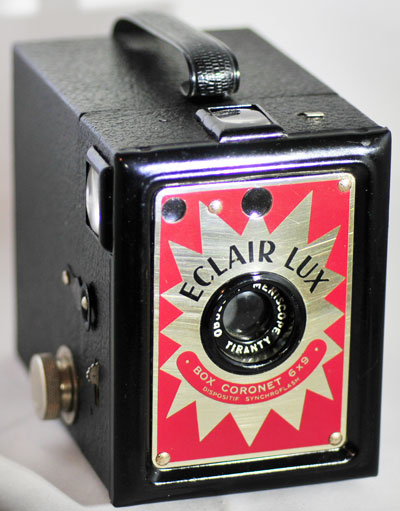Tiranty Eclair Lux
Specification

| Manufacturer | : | Tiranty under licence from Coronet |
|---|---|---|
| Produced | : | 1950 |
| Classification | : | Medium Format |
| Body Type | : | Box |
| Construction | : | Metal/Wood |
| Film Type | : | 120 |
| Film Width | : | 62mm |
| Image Size | : | 6 x 9 cm |
| No. of Images | : | 8 |
| Lens Type | : | Tiranty Meniscus |
| Focal Length | : | 105mm |
| Focus Type | : | Fixed |
| Focus Range | : | 3m to inf. |
| Aperture Type | : | Fixed |
| Aperture | : | f/13 |
| Shutter Type | : | Rotary |
| Shutter Speeds | : | B, I*(1/30 sec) |
| Size (w x h x d) | : | 75 x 103 x 120 mm |
| Weight | : | 518g |
| * Measured on this camera | ||
Art Deco Credentials
![]()
![]()
Acceptable: Modest and restricted
- Produced after the main Art Deco period;
- Red enamel on chrome front plate;
- Geometric 'flash' design on front plate;
- Chrome film winder;
Description
The Eclair Lux camera was manufactured by the Tiranty Company located in Paris, France. It was also labelled as a Box Coronet. It was produced in partnership with the Coronet Camera Co. of the UK. The partnership circumvented the import restrictions imposed by the French government after WWII.
The camera is designed for taking eight 6 x 9 cm exposures on number 120 roll film. It has a red window which are used to get 8 exposures from 120 film. The body of the camera is made from leatherette covered metal. Internally, a wooden block is used to mount the shutter mechanism and viewfinders.
It features a Tiranty meniscus lens and instantaneous shutter. The shutter has two settings: instant or time, although the time setting is more like 'bulb'. There is a tab to pull to switch between instant and time exposures on the top of the camera. The film advance is not coupled to the shutter release so double exposure is possible.
It features a top mounted plastic handle. Two view finders are provided to give both portrait and landscape views. Two posts on the side of the camera allow for connection for synchronized flash.
How to Use
This camera takes 120 film which is easily available.
As the shutter speed is only 1/30s, it is advisable to use a tripod to get clear shake free images. However, holding it against a wall or other solid object would work as well. For quick snapshots, hold it firmly against your body.
If you don't want to bother with an exposure meter, follow the guide shown. It is based on the 'Sunny 16' rule. Film is so forgiving and will produce acceptable results even when overexposed by 2 or 3 stops or underexposed by 1 stop.
The tables assume that the sun is at least 30 degrees above the horizon - that's 10am - 5pm on a summers day (May - August) in the UK.
Remember that the exposure guide in the manual may not be helpful as it is based on the use of old film with a low ISO value.
Using ISO 100/125 film - shutter speed 1/30s
| Weather Conditions | Shadow Detail | Aperture | Exposure |
|---|---|---|---|
 Sunny SunnySnow/Sand | Dark with sharp edges | f/13 | +3½ Stops Overexposed Not Acceptable |
 Sunny Sunny | Distinct | f/13 | +2½ Stops Overexposed Acceptable |
 Slight Overcast Slight Overcast | Soft around edges | f/13 | +1½ Stops Overexposed Acceptable |
 Overcast Overcast | Barely visible | f/13 | +½ Stop Overexposed Acceptable |
 Heavy Overcast Heavy Overcast | None | f/13 | -½ Stop Underexposed Acceptable |
 Open Shade Open Shade/Sunset | None | f/13 | -1½ Stops Underexposed Not Acceptable |